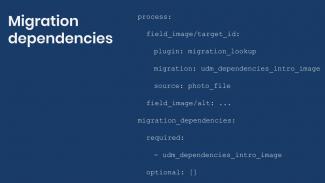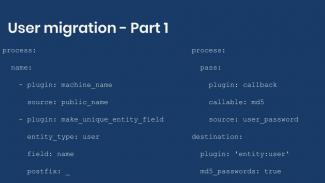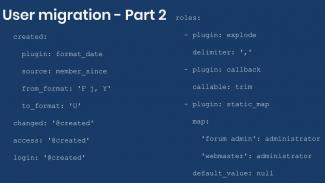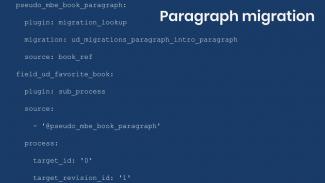
Using constants and pseudofields as data placeholders in the Drupal migration process pipeline
So far we have learned how to write basic Drupal migrations and use process plugins to transform data to meet the format expected by the destination. In the previous entry we learned one of many approaches to migrating images. In today’s example, we will change it a bit to introduce two new migration concepts.

Tips for writing Drupal migrations and understanding their workflow
We have presented several examples as part of this migration blog post series. Today we are going to talk about what happens after import and rollback operations, how to recover from a failed migration, and some tips for writing definition files.

Migrating files and images into Drupal
We have already covered two of many ways to migrate images into Drupal. Today, we are going to perform an image migration that will clear after itself when it is rolled back. Note that in Drupal images are a special case of files. Even though the example will migrate images, the same approach can be used to import any type of file.

Introduction to migration dependencies in Drupal
One of Drupal’s biggest strengths is its data modeling capabilities. You can break the information that you need to store into individual fields and group them in content types. Today we will learn about migration dependencies in Drupal.

Migrating taxonomy terms and multivalue fields in Drupal
This example consists of two separate migrations. One to import taxonomy terms accounting for term hierarchy. And another to import into a multivalue taxonomy term field. Following this approach, any node and taxonomy term created by the migration process will be removed from the system upon rollback.

Migrating users into Drupal - Part 1
Today we are going to learn how to migrate users into Drupal. The example code will be explained in two blog posts. In this one, we cover the migration of email, timezone, username, password, and status.

Migrating users into Drupal - Part 2
Today we complete the user migration example. This time, we cover creation date, roles, and profile pictures and we are jumping straight to the process transformations in this entry.

Migrating dates into Drupal
Today we will learn how to migrate dates into Drupal. Depending on your field type and configuration, there are various possible combinations. In addition to the examples, a list of things to consider when migrating dates is also presented.

Migrating addresses into Drupal
Today we will learn how to migrate addresses into Drupal. The address components can change per country, and the way to store those components also varies per country. These and other important considerations will be explained.

Introduction to paragraphs migrations in Drupal
Today we will present an introduction to paragraphs migrations in Drupal. The example consists of migrating paragraphs of one type, then connecting the migrated paragraphs to nodes.
Pagination
- Previous page
- Page 10
- Next page

